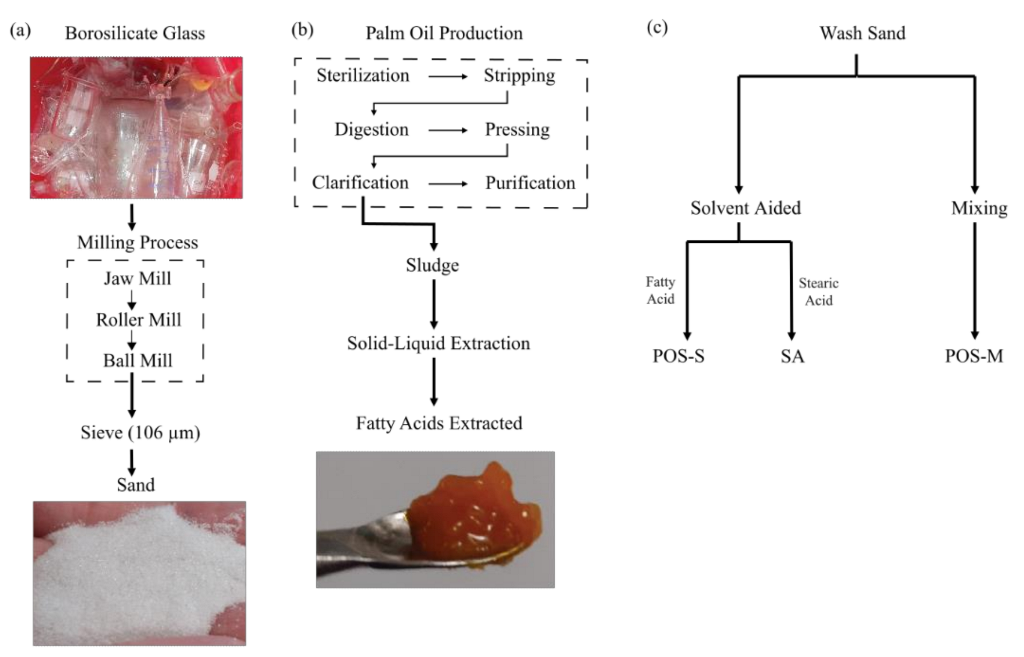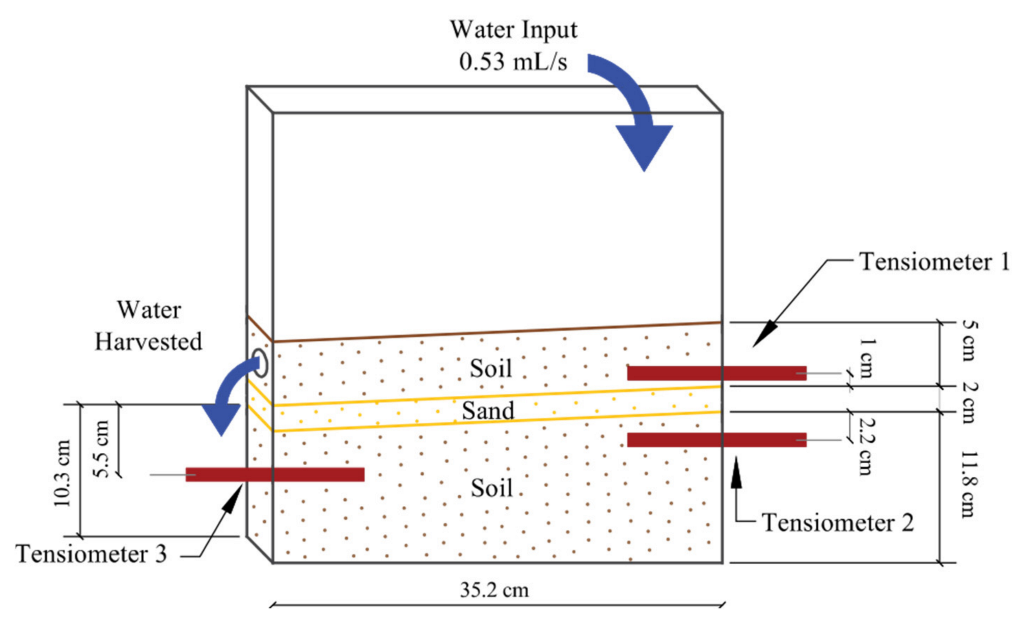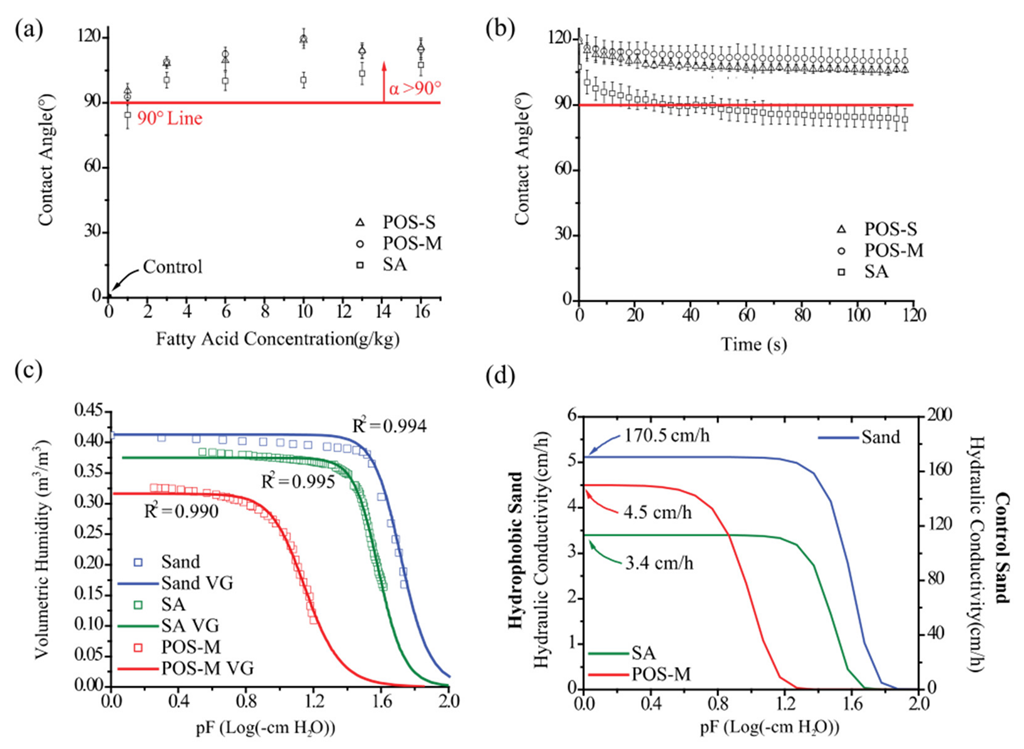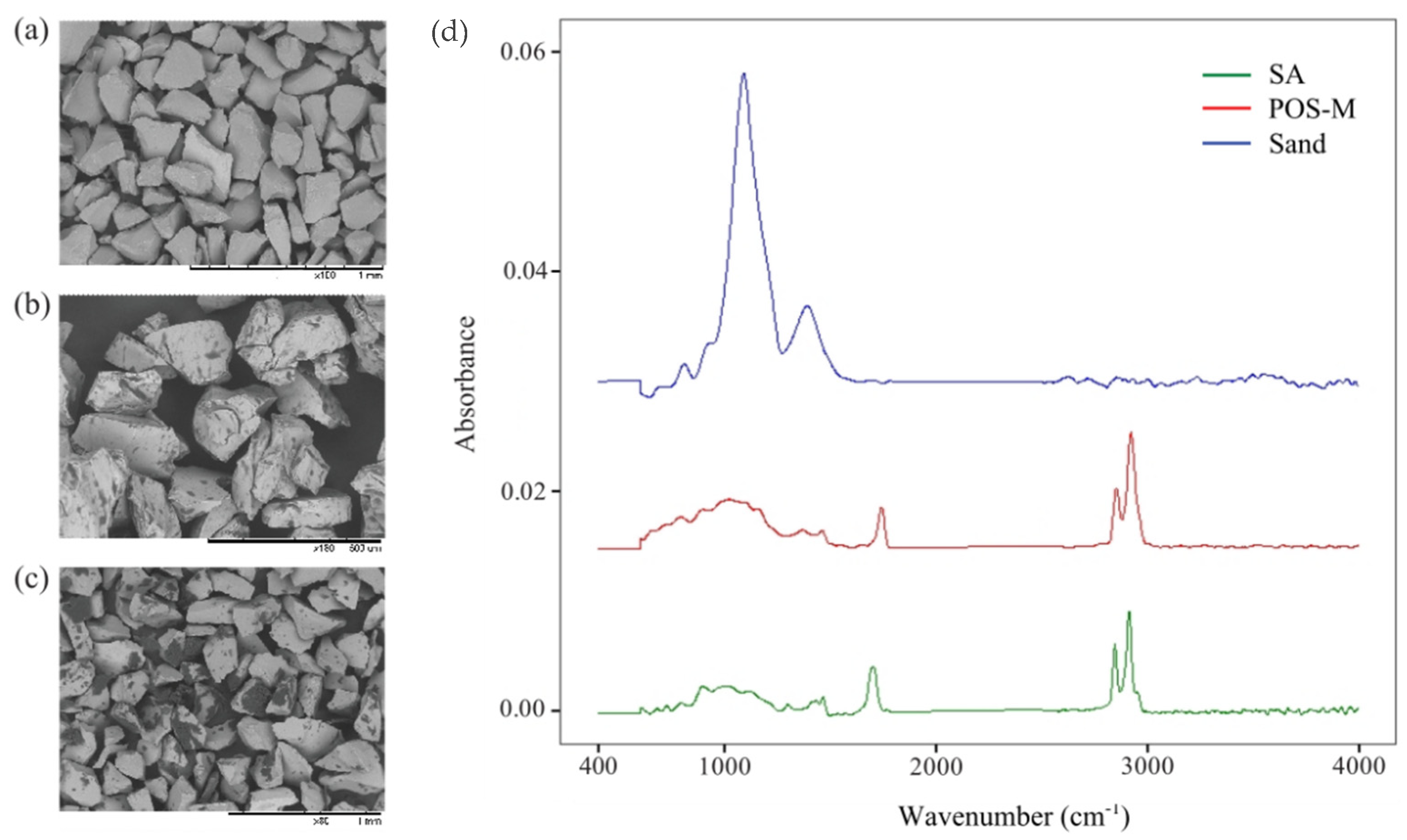Crushed Glass and Oil Extracted from Palm Oil Sludge as Primary Materials in the Production of Hydrophobic Sand for Capillary Barrier Applications
Abstract
1. Introduction
2. Materials and Methods
2.1. Sample Collection and Preparation
2.2. Particle Size Analysis
2.3. Characterization of Fatty Acids Extracted
2.4. Contact Angle Analysis
2.5. Hydraulic Properties
2.5.1. Water Characteristic Curves
2.5.2. Saturated Hydraulic Conductivity
2.6. Characterization of Hydrophobic Sand
2.6.1. Images
2.6.2. ATR-FTIR
2.7. Qualitative Assessment of Capillary Barrier Effect of Hydrophobic Sand
2.7.1. Characterization of Soil
2.7.2. Qualitative Assessment
3. Results
3.1. Transformation of Glass and Palm Oil Waste into Hydrophobic Sand
3.1.1. Extraction of Fatty Acids from Palm Oil Waste Sludge and Glass Crushed into Sand
3.1.2. Evaluation of Hydrophobic Sand
3.2. Qualitative Assessment of Capillary Barrier Effect
4. Discussion
5. Conclusions
Author Contributions
Funding
Institutional Review Board Statement
Informed Consent Statement
Data Availability Statement
Acknowledgments
Conflicts of Interest
References
- Zhan, L.; Li, G.; Jiao, W.; Lan, J.; Chen, Y.; Shi, W. Performance of a Compacted Loess/Gravel Cover as a Capillary Barrier and Landfill Gas Emissions Controller in Northwest China. Sci. Total Environ. 2020, 718, 137195. [Google Scholar] [CrossRef] [PubMed]
- Wijewardana, N.S.; Kawamoto, K.; Moldrup, P.; Komatsu, T.; Kurukulasuriya, L.C.; Priyankara, N.H. Characterization of Water Repellency for Hydrophobized Grains with Different Geometries and Sizes. Environ. Earth Sci. 2015, 74, 5525–5539. [Google Scholar] [CrossRef]
- Solanki, B.; Gapak, Y.; Tadikonda, B.V. Capillary Barrier Effects in Unsaturated Layered Soils. In Proceedings of the International Conference on Soil and Environment, Bangalore, India, 22–23 July 2016; pp. 1–8. [Google Scholar]
- Simon, F.; Müller, W.W. Standard and Alternative Landfill Capping Design in Germany. Environ. Sci. Policy 2004, 7, 277–290. [Google Scholar] [CrossRef]
- Zheng, S.; Xing, X.; Lourenço, S.D.N.; Cleall, P.J. Cover Systems with Synthetic Water-Repellent Soils. Vadose Zone J. 2021, 20, 1–15. [Google Scholar] [CrossRef]
- Khire, M.V.; Benson, C.H.; Bosscher, P.J. Field Data from a Capillary Barrier and Model Predictions with UNSAT-H. J. Geotech. Geoenviron. Eng. 1999, 125, 518–527. [Google Scholar] [CrossRef]
- Stormont, J.C.; Anderson, C.E. Capillary Barrier Effect from Underlying Coarser Soil Layer. J. Geotech. Geoenviron. Eng. 1999, 125, 641–648. [Google Scholar] [CrossRef]
- Meerdink, J.; Benson, C.; Khire, M. Unsaturated Hydraulic Conductivity of Two Compacted Barrier Soils. J. Geotech. Eng. 1996, 122, 565–576. [Google Scholar] [CrossRef]
- Khire, M.V.; Benson, C.H.; Bosscher, P.J. Capillary Barriers: Design Variables and Water Balance. J. Geotech. Geoenviron. Eng. 2000, 126, 695–708. [Google Scholar] [CrossRef]
- Dell’Avanzi, E.; Guizelini, A.P.; da Silva, W.R.; Nocko, L.M. Potential Use of Induced Soil-Water Repellency Technique to Improve the Performance of Landfill’s Alternative Final Cover Systems. In Proceedings of the 4th Asia-Pacific Conference on Unsaturated Soils (UNSAT 2009), Newcastle, Australia, 23–25 November 2009; pp. 461–466. [Google Scholar]
- Subedi, S.; Kawamoto, K.; Jayarathna, L.; Vithanage, M.; Moldrup, P.; Wollesen de Jonge, L.; Komatsu, T. Characterizing Time-Dependent Contact Angles for Sands Hydrophobized with Oleic and Stearic Acids. Vadose Zone J. 2012, 11, vzj2011.0055. [Google Scholar] [CrossRef]
- Subedi, S.; Hamamoto, S.; Komatsu, T.; Kawamoto, K. Development of Hydrophobic Capillary Barriers for Landfill Covers System: Assessment of Water Repellency and Hydraulic Properties of Water Repellent Soils. Res. Rep. Dep. Civ. Environ. Eng. Saitama Univ. 2013, 39, 33–44. [Google Scholar]
- Choi, Y.; Choo, H.; Yun, T.S.; Lee, C.; Lee, W. Engineering Characteristics of Chemically Treated Water-Repellent Kaolin. Materials 2016, 9, 978. [Google Scholar] [CrossRef] [PubMed]
- Saenz, A. Waterproof Nanotech Sand Could Change Deserts into Farms. Available online: https://singularityhub.com/2009/09/17/waterproof-nanotech-sand-could-change-deserts-into-farms/ (accessed on 20 July 2022).
- Zyga, L. Hydrophobic Sand Could Combat Desert Water Shortages. Available online: https://phys.org/news/2009-02-hydrophobic-sand-combat-shortages.html (accessed on 20 July 2022).
- Jones, J.V.; Ohlberg, S.M. Flat Glass Composition with Improved Melting and Tempering Properties. U.S. Patent No 5,071,796, 10 December 1991. [Google Scholar]
- George, W.M. The Composition of Glass. Am. Assoc. Adv. Sci. 1936, 42, 542–554. [Google Scholar] [CrossRef]
- Bravo, M.; Brito, J.; de Pontes, J.; Evangelista, L. Mechanical Performance of Concrete Made with Aggregates from Construction and Demolition Waste Recycling Plants. J. Clean. Prod. 2015, 99, 59–74. [Google Scholar] [CrossRef]
- WACA. What Can Be Done about West Africa’s Disappearing Sand? 2018, pp. 1–4. Available online: https://weandb.org/wp-content/uploads/2018/03/ks_west-africa-is-running-out-en-v1-20171114.pdf (accessed on 12 October 2021).
- Kaza, S.; Yao, L.; Bhada-Tata, P.; Van Woerden, F. What a Waste 2.0: A Global Snapshot of Solid Waste Management to 2050; World Bank Group: Washington, DC, USA, 2018; Volume 7, ISBN 9772081415. [Google Scholar]
- Wartman, J.; Grubb, D.G.; Nasim, A.S.M. Select Engineering Characteristics of Crushed Glass. J. Mater. Civ. Eng. 2004, 16, 526–539. [Google Scholar] [CrossRef]
- Kazmi, D.; Serati, M.; Williams, D.J.; Qasim, S.; Cheng, Y.P. The Potential Use of Crushed Waste Glass as a Sustainable Alternative to Natural and Manufactured Sand in Geotechnical Applications. J. Clean. Prod. 2021, 284, 124762. [Google Scholar] [CrossRef]
- Limbachiya, M.C. Bulk Engineering and Durability Properties of Washed Glass Sand Concrete. Constr. Build. Mater. 2009, 23, 1078–1083. [Google Scholar] [CrossRef]
- Imteaz, M.A.; Ali, M.Y.; Arulrajah, A. Possible Environmental Impacts of Recycled Glass Used as a Pavement Base Material. Waste Manag. Res. 2012, 30, 917–921. [Google Scholar] [CrossRef] [PubMed]
- Lai, O.; Phuah, E.; Lee, Y.; Basiron, Y. Palm Oil. In Bailey’s Industrial Oil and Fat Products; John Wiley and Sons: Hoboken, NJ, USA, 2020; pp. 1–101. ISBN 047167849X. [Google Scholar]
- Lai, O.-M.; Tan, C.-P.; Akoh, C. Palm Oil: Production, Processing, Characterization and Uses; AOCS Press: Sommerville, MA, USA, 1995. [Google Scholar]
- Obi, O.F. Evaluation of the Effect of Palm Oil Mill Sludge on the Properties of Sawdust Briquette. Renew. Sustain. Energy Rev. 2015, 52, 1749–1758. [Google Scholar] [CrossRef]
- Obi, O.F.; Okongwu, K.C. Characterization of Fuel Briquettes Made From a Blend of Rice Husk and Palm Oil Mill Sludge. Biomass Convers. Biorefinery 2016, 5, 449–456. [Google Scholar] [CrossRef]
- Lee, X.J.; Hiew, B.Y.Z.; Lai, K.C.; Tee, W.T.; Thangalazhy-Gopakumar, S.; Gan, S.; Lee, L.Y. Applicability of a Novel and Highly Effective Absorbent Derived From Industrial Palm Oil Mill Sludge for Copper Sequestration: Central Composite Design Optimization and Adsorption Performance Evaluation. J. Environ. Chem. Eng. 2021, 9, 105968. [Google Scholar] [CrossRef]
- Iberahim, N.; Sethupathi, S.; Bashir, M.J.K. Optimization of Palm Oil Mill Sludge Biochar Preparation for Sulfur Dioxide Removal. Environ. Sci. Pollut. Res. 2018, 25, 25702–25714. [Google Scholar] [CrossRef] [PubMed]
- Yaser, A.Z.; Rahman, R.A.; Kalil, M.S. Co-Composting of Palm Oil Mill Sludge-Sawdust. Pakistan J. Biol. Sci. 2007, 10, 4473–4478. [Google Scholar] [CrossRef]
- Rupani, P.F.; Singh, R.P.; Ibrahim, M.H.; Esa, N. Review of Current Palm Oil Mill Effluent (POME) Treatment Methods: Vermicomposting as a Sustainable Practice Cite This Paper Related Papers Management of Biomass Residues Generat Ed from Palm Oil Mill: Vermicompost Ing a Sust Aina… Norizan Esa A Review On. World Appl. Sci. J. 2010, 10, 1190–1201. [Google Scholar]
- Nuchdang, S.; Phruetthinan, N.; Paleeleam, P.; Domrongpokkaphan, V.; Chuetor, S.; Chirathivat, P.; Phalakornkule, C. Soxhlet, Microwave-Assisted, and Room Temperature Liquid Extraction of Oil and Bioactive Compounds from Palm Kernel Cake Using Isopropanol as Solvent. Ind. Crops Prod. 2022, 176, 114379. [Google Scholar] [CrossRef]
- Zamanhuri, N.A.; Rahman, N.A.; Bakar, N.F.A. Extraction of Palm Fatty Acids from Sterilized Oil Palm Mesocarp by Microwave Technique: Optimization and Kinetics. Mater. Today Proc. 2022, 63, 166–173. [Google Scholar] [CrossRef]
- Priego-Capote, F. Solid–Liquid Extraction Techniques. In Analytical Sample Preparation with Nano- and Other High-Performance Materials; Lucena, R., Cárdenas, S., Eds.; Elsevier: Amsterdam, The Netherlands, 2021; pp. 111–130. [Google Scholar]
- Daso, A.P.; Okonkwo, O.J. Conventional Extraction Techniques: Soxhlet and Liquid–Liquid Extractions and Evaporation. In Analytical Separation Science; John Wiley and Sons: Hoboken, NJ, USA, 2015; ISBN 9783527678129. [Google Scholar]
- Zimila, H.; Mandlate, J.; Artur, E.; Muaimbo, H.; Uamusse, A. Vortex-Assisted Solid-Liquid Extraction for Rapid Screening of Oil Content in Jatropha Seed: An Alternative to the Modified Soxhlet Method. S. Afr. J. Chem. 2021, 75, 1–5. [Google Scholar] [CrossRef]
- Vernès, L.; Vian, M.; Chemat, F. Ultrasound and Microwave as Green Tools for Solid-Liquid Extraction. In Liquid-Phase Extraction; Elsevier: Avignon, France, 2020; pp. 355–374. [Google Scholar]
- Mahindrakar, K.; Rathod, V. Ultrasound-Assisted Extraction of Lipids, Carotenoids, and Other Compounds from Marine Resources. In Innovative and Emerging Technologies in the Bio-Marine Food Sector; García-Vaquero, M., Rajauria, G., Eds.; Academic Press: Cambridge, MA, USA, 2022; pp. 81–128. [Google Scholar]
- Cervera-Mata, A.; Aranda, V.; Ontiveros-Ortega, A.; Comino, F.; Martín-García, J.M.; Vela-Cano, M.; Delgado, G. Hydrophobicity and Surface Free Energy to Assess Spent Coffee Grounds as Soil Amendment. Relationships with Soil Quality. Catena 2021, 196, 1–14. [Google Scholar] [CrossRef]
- Doerr, S.H.; Shakesby, R.A.; Walsh, R.P.D. Soil Water Repellency: Its Causes, Characteristics and Hydro-Geomorphological Significance. Earth Sci. Rev. 2000, 51, 33–65. [Google Scholar] [CrossRef]
- Chan, C.S.H.; Lourenço, S.D.N. Comparison of Three Silane Compounds to Impart Water Repellency in an Industrial Sand. Geotech. Lett. 2016, 6, 1–4. [Google Scholar] [CrossRef]
- Zhou, Z.; Leung, A.K.; Karimzadeh, A.A.; Lau, C.H.; Li, K.W. Infiltration through an Artificially Hydrophobized Silica Sand Barrier. J. Geotech. Geoenviron. Eng. 2021, 147, 06021006. Available online: https://hdl.handle.net/1783. [CrossRef]
- Leelamanie, D.A.L.; Karube, J. Time Dependence of Contact Angle and Its Relation to Repellency Persistence in Hydrophobized Sand. Jpn. Soc. Soil Sci. Plant Nutr. 2009, 55, 457–461. [Google Scholar] [CrossRef]
- Bachmann, J.; Horton, R.; van der Ploeg, R.R.; Woche, S. Modified Sessile Drop Method for Assessing Initial Soil-Water Contact Angle of Sandy Soil. Soil Sci. Soc. Am. J. 2000, 64, 564–567. [Google Scholar] [CrossRef]
- González-Peñaloza, F.A.; Zavala, L.M.; Jordán, A.; Bellinfante, N.; Bárcenas-Moreno, G.; Mataix-Solera, J.; Granged, A.J.P.; Granja-Martins, F.M.; Neto-Paixão, H.M. Water Repellency as Conditioned by Particle Size and Drying in Hydrophobized Sand. Geoderma 2013, 209, 31–40. [Google Scholar] [CrossRef]
- Hasanuzzaman, M.; Rafferty, A.; Sajjia, M.; Olabi, A. Materials Science and Materials Engineering; Elsevier: Amsterdam, The Netherlands, 2016. [Google Scholar]
- Sivakugan, N. Soil Classification. In Soil Mechanics and Foundation Engineering: Fundamentals and Applications; McGraw Hill: New York, NY, USA, 2021. [Google Scholar]
- Vesilind, A. The Rosin-Rammler Particle Size Distribution. Resour. Recover. Conserv. 1980, 5, 275–277. [Google Scholar] [CrossRef]
- Kranias, S.; GmbH, K. Effect of Drop Volume on Static Contact Angles; KRÜSS GmbH: Hamburg, Germany, 2004. [Google Scholar]
- Van Genuchten, M.T.; Leij, F.J.; Yates, S.R. The RETC Code for Quantifying the Hydraulic Functions of Unsaturated Soils. Environmental Protection Agency, 1991. Available online: https://www.pc-progress.com/Documents/programs/retc.pdf (accessed on 23 September 2022).
- Van Genuchten, M.T. A Closed-Form Equation for Predicting the Hydraulic Conductivity of Unsaturated Soils. Soil Sci. Soc. Am. J. 1980, 44, 892–898. [Google Scholar] [CrossRef]
- Reynolds, W.D.; Elrick, D.E.; Youngs, E.G.; Booltink, H.W.G.; Bouma, J. Physical Methods. In Methods of Soil Analysis; Dane, J., Topp, C., Eds.; Soil Science Society of America: Madison, WI, USA, 2002; pp. 802–816. [Google Scholar]
- Šimůnek, J.; Šejna, M.; Saito, H.; Sakai, M.; van Genuchten, M.T. The Hydrus-1D Software Package for Simulating the One-Dimensional Movement of Water, Heat and Multiple Solutes in Variably-Saturated Media. University of Environmental Sciences, 2009. Available online: https://www.pc-progress.com/Downloads/Pgm_hydrus1D/HYDRUS1D-4.08.pdf (accessed on 23 September 2022).
- Mata-Chinchilla, R.; Ibarra, R.; Gerardo, A.; Sandoval, D. Subórdenes de Suelo de Costa Rica; Asociación Costarricenses de Ciencias del Suelo: 2013. Available online: https://catalogosiidca.csuca.org/Record/UCR.000439870#similar (accessed on 23 September 2022).
- Gee, G.; Or, D. Particle Size Analysis. In Methods of Soil Analysis; Dane, J., Topp, C., Eds.; Soil Science Society of America: Madison, WI, USA, 2002; Volume 3, pp. 225–282. [Google Scholar]
- Dane, J.; Hopmans, J. Water Retention and Storage. In Methods of Soil Analysis; Dane, J., Topp, C., Eds.; Soil Science Society of America: Madison, WI, USA, 2002; p. 677. [Google Scholar]
- Eijkelkamp Soil & Water User Manual: Sandbox for PF-Determination. 2019, pp. 1–25. Available online: https://www.royaleijkelkamp.com/media/ny1lqhyr/m-0801e-sandbox-for-pf-determination.pdf (accessed on 4 August 2021).
- Meter Group Inc WP4C Operator’s Manual. 2021. Available online: https://manuals.plus/meter/wp4c-water-potential-meter-manual (accessed on 23 September 2022).
- Watson, C.; Letey, J. Indices for Characterizing Soil-Water Repellency Based Upon Contact Angle-Surface Tension Relationships. Soil Sci. Soc. Am. J. 1970, 34, 841–844. [Google Scholar] [CrossRef]
- Iley, W.J. Effect of Particle Size and Porosity on Particle Film Coatings. Powder Technol. 1991, 65, 441–445. [Google Scholar] [CrossRef]
- Liu, H.; Ju, Z.; Bachmann, J.; Horton, R.; Ren, U. Moisture-Dependent Wettability of Artificial Hydrophobic Soils and Its Relevance for Soil Water Desorption Curves. Soil Sci. Soc. Am. J. 2012, 76, 342–349. [Google Scholar] [CrossRef]







| Fatty Acid | Concentration (g/100 g) |
|---|---|
| Capric Acid C10:0 | 0.0145 ± 0.0025 |
| Lauric Acid C12:0 | 0.188 ± 0.032 |
| Myristic Acid C14:0 | 1.22 ± 0.21 |
| Palmitic Acid C16:0 | 54.1 ± 9.2 |
| Pentadecanoic Acid C15:0 | 0.0400 ± 0.0068 |
| Pentadecanoic Acid C15:1 | 0.0112 ± 0.0019 |
| Oleic Acid C18:1 | 36.7 ± 6.2 |
| Linoleic Acid C18:2 | 7.7 ± 1.3 |
| Saturated Fat | 55.6 ± 5.3 |
| Monounsaturated Fat | 36.7 ± 2.8 |
| Polyunsaturated Fat | 7.71 ± 0.74 |
| Sand | θs (cm3 cm−3) | α (cm−1) | n | m |
|---|---|---|---|---|
| Control Sand | 0.41 | 0.0199 | 5.544 | 0.820 |
| SA | 0.37 | 0.0269 | 6.139 | 0.837 |
| POS-M | 0.32 | 0.0758 | 4.543 | 0.780 |
Publisher’s Note: MDPI stays neutral with regard to jurisdictional claims in published maps and institutional affiliations. |
© 2022 by the authors. Licensee MDPI, Basel, Switzerland. This article is an open access article distributed under the terms and conditions of the Creative Commons Attribution (CC BY) license (https://creativecommons.org/licenses/by/4.0/).
Share and Cite
Sullivan-Porras, J.; Badilla-Sánchez, M.; Rimolo-Donadio, R.; Masís-Meléndez, F. Crushed Glass and Oil Extracted from Palm Oil Sludge as Primary Materials in the Production of Hydrophobic Sand for Capillary Barrier Applications. Sustainability 2022, 14, 12770. https://doi.org/10.3390/su141912770
Sullivan-Porras J, Badilla-Sánchez M, Rimolo-Donadio R, Masís-Meléndez F. Crushed Glass and Oil Extracted from Palm Oil Sludge as Primary Materials in the Production of Hydrophobic Sand for Capillary Barrier Applications. Sustainability. 2022; 14(19):12770. https://doi.org/10.3390/su141912770
Chicago/Turabian StyleSullivan-Porras, Josefina, María Badilla-Sánchez, Renato Rimolo-Donadio, and Federico Masís-Meléndez. 2022. "Crushed Glass and Oil Extracted from Palm Oil Sludge as Primary Materials in the Production of Hydrophobic Sand for Capillary Barrier Applications" Sustainability 14, no. 19: 12770. https://doi.org/10.3390/su141912770
APA StyleSullivan-Porras, J., Badilla-Sánchez, M., Rimolo-Donadio, R., & Masís-Meléndez, F. (2022). Crushed Glass and Oil Extracted from Palm Oil Sludge as Primary Materials in the Production of Hydrophobic Sand for Capillary Barrier Applications. Sustainability, 14(19), 12770. https://doi.org/10.3390/su141912770








